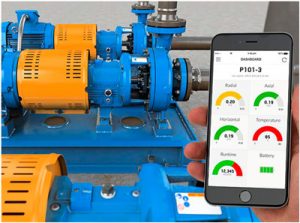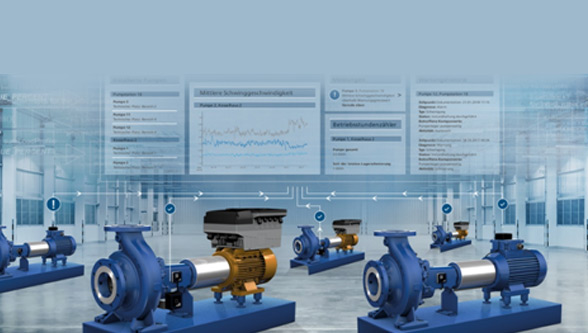The ability for smart valves and pumps to improve process performance, condition monitoring and maintenance effectiveness is substantial. It is obvious that advanced diagnostics and bidirectional communications can also improve environmental compliance and plant safety. It’s nobody’s guess that in the post-Covid world, this trend will accelerate, as maintenance managers in manufacturing plants may have to operate under lockdown pressures and service engineers will obviously witness difficulties in visiting client premises.
Incidentally, although end users in the process industries began to digitise their plants decades ago with the introduction of “smart/intelligent”, digitally integrated process transmitters and final control devices, pumps and valves have often been last in the queue.
As far as the processing industries are concerned e.g. chemical processing, food and beverage, water, wastewater, oil and gas, mining, building services, pulp and paper—pumps are found everywhere. The pumping machines used in those industries differ widely and each requires expert handling.
Infrastructure, large buildings and various industries globally use more than 300 million electric motors. These electric motors consume about two-thirds of the industrial power consumption. Moreover, electricity is required in almost all areas of the plant to provide the driving force that either operates the equipment that produces the products or provides the services that the plant’s equipment was built to perform.
Pumps are increasingly required to supply real-time operating data on the smart factory shop floor, so that their performance can be monitored and adjusted. One of the key performance indicators is the torque: a gradual increase in pump torque may suggest increasing flow to compensate for growing leakage; a sudden increase may indicate a clogging of the pump downstream, while a sudden reduction may be due to an upstream blockage.
Another problem is how to connect torque sensors to equipment such as pumps, mixers and conveyors. It is indeed possible to wire up one machine using a delicate slip ring, but a highly automated factory may have hundreds or thousands, so the task becomes very difficult. However, an alternative approach is to use a non-contact radio frequency detector.
Established maintenance plans can vary from daily monitoring to less-frequent inspections and repairs depending on the criticality and the application. Moreover, making sure that valves meet operational standards requires detailed record-keeping and right-skilled talent to oversee the repair.
To help factory operators respond to urgent issues, a company called Emerson has launched a Remote Assistance service which uses augmented reality (AR) to facilitate real-time repair. Although factory personnel can securely share their field of view through the AR software using a mobile device, enabling Emerson’s valve engineers troubleshoot and solve the problem. Detailed instructions are given in the field-user’s application to support installation, calibration or repair actions.
Director of Emerson’s digital valve services, Clint Schneider, says, “mostly, our clients are supporting critical infrastructure through the global health crisis that we’re experiencing though they still encounter issues where they need outside help. With the help of this technology, we are able to continue our promise of support while protecting essential on-site staff and Emerson technicians.”
In one application, a Peristaltic pump has internal tubing that separates media from pump components and offers a sanitary method to supply the bioreactor with various fluids to grow cell cultures in the development of new medicines. In another application, Stepper motors power the pump head, compressing and releasing the pump tubing to move media into the bioreactor chamber.

In order to remove excessive heat in its open-loop, Stepper motors have been replaced with closed-loop counterparts. Excessive heat elevates the temperature of fluids being pumped into the bioreactor, which adversely affect processing times and reduce yields.
Hence, by incorporating encoder feedback and servo-control firmware in Applied Motion Products’ closed-loop Steppers, the current is controlled to meet torque demands precisely. This eliminate the heat problem by operating less hot and consuming less power.
The hybrid valve market size globally is expected to grow at a substantial CAGR of 6.7 per cent during 2019 to 2026. The growth can be attributed to the increasing use of 3D printers in valve manufacturing.
Despite the fact that there is no evidence that the novel coronavirus can be transmitted via food, transmission via surfaces recently contaminated with viruses is, nonetheless, believed possible through smear infections.
The Iris pipeline X-ray system, designed by Sparc Systems, can detect contaminants in vacuum filled and pumped meat, poultry and dairy products.
The Iris system can identify many different physical hazards, including bones, teeth, metal, glass, ceramics, and high-density plastic in muscle meats, slurries, semi solids, and fluids. The X-ray sensor is able to detect foreign materials with high sensitivity levels down to 0.4mm.
Whenever any product is shown to contain contaminant on a display screen and immediately rejected from the system before it is transferred downstream.
In its pursuit of optimum efficiency, the Iris pipeline system features a three-way electric valve that allows test pieces to be inserted into the product flow to provide a true performance reading. Beside rapid setting up and ease of use across mixed product lines, it can also easily be integrated into an existing rigid or flexible piping system or placed behind a vacuum filling machine.
With increasing water scarcity, the mining industry is seeking sustainable strategies to address rising risks, costs and compliances. However, the way rising volumes of mine tailings are handled can have a long-term impact on a mine’s economic efficiency as well as on the surrounding environment and communities. Straining the water from this waste allows its reuse, either in the plant itself or restoration to nature.
Hence, finding the most effective solution to upgrade a pumping station can be a complex process. It is important that a balance between improved performance and minimised costs is struck which, in turn, requires experience and excellent technical abilities. But one thing is sure and that is, technically advanced pumps and valves would be playing a crucial role in industries across sectors in the days to come.
Article by Arijit Nag
Arijit Nag is a freelance journalist who writes on various aspects of the economy and current affairs.
Read more article of Arijit Nag
ENGINEERING REVIEW provides cognitive exchange of information on the manufacturing sector, which will facilitate you keep updated on a real time basis.
Please follow our magazine page and also join our LinkedIn Group- exclusive group created for manufacturing professionals community
Join us on LinkedIn Group : https://www.linkedin.com/groups/10477764/
Follow us on LinkedIn : https://www.linkedin.com/company/engineering-review/



